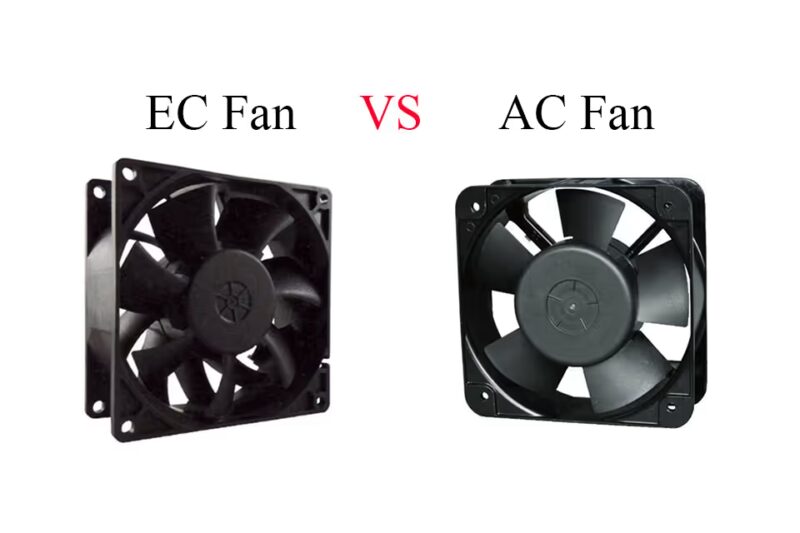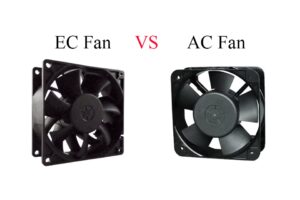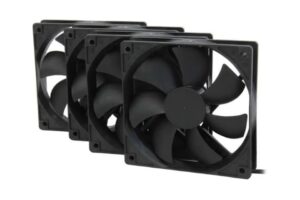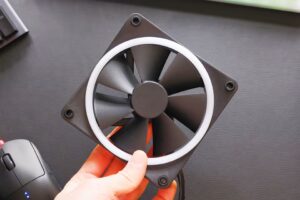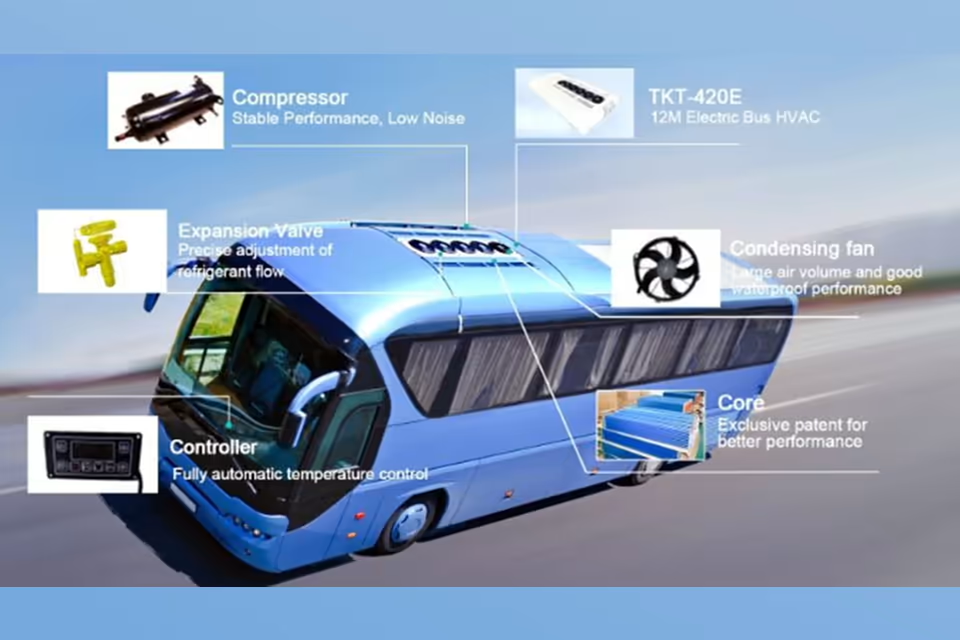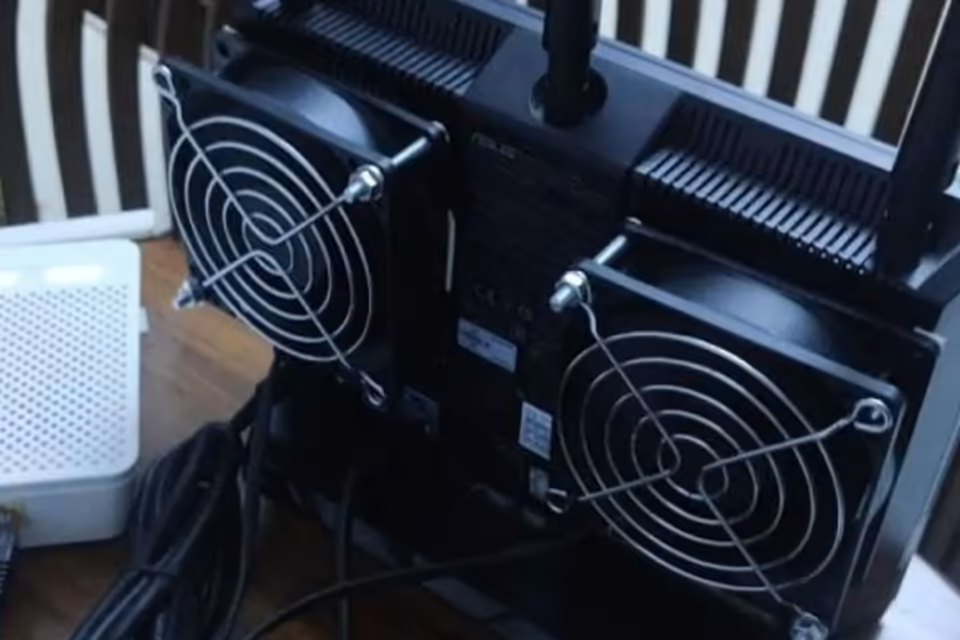電子整流(EC)ファンと交流(AC)ファンの比較は、様々な産業、特にHVAC、冷凍、データセンターにおけるエネルギー効率と持続可能性に関する議論において、ますます重要性を増しています。
高度な電子制御を利用して消費電力を最適化するECファンは、ACファンの一般的な70%と比較して最大90%という優れたエネルギー効率により、環境意識の高い消費者や企業にとって好ましい選択肢として注目を集めています。エネルギーコストの上昇と規制の強化に伴い、ECファンへの移行は、ビル管理や産業用途における持続可能な慣行への傾向の高まりを反映しています。
ECファンは、運用ニーズに基づいて電力使用量を動的に調整する能力が際立っており、時間の経過とともにエネルギー消費量の削減と運用コストの低減をもたらします。また、騒音低減、メンテナンス要件、長寿命においても大きな利点があり、初期投資は高くなるものの、長期的にはより費用対効果が高くなる可能性があります。
対照的に、ACファンは通常購入費用は安いものの、固定速度での動作と高いエネルギー消費量によって制限され、エネルギーに敏感なアプリケーションでは運用費用が増加する可能性があります。
これらの技術の環境への影響は、ECファンが温室効果ガス排出量の削減と室内空気質の向上に貢献するため、その重要性をさらに強調しています。
しかし、市場のダイナミクスは進化しており、より高度なECファンからの競争が激化する中で、ACファンは新しいエネルギー効率基準に適応するよう圧力を受けています。
持続可能性が消費者の好みや規制の枠組みを形成し続ける中、ECファンとACファンの最終的な対決は、エネルギー効率の高い技術の未来を理解するための重要な焦点となっています。
ECファン
電子整流(EC)ファンは、特に冷凍、HVACシステム、コンピューター室空調ユニットなど、様々な用途で極めて重要な技術として登場しました。ECファンへの需要の増加は、スマートビルディングやスマートホームの台頭、および省エネルギーと持続可能性への関心の高まりと密接に関連しています。
これらのファンは、優れたエネルギー効率で知られており、運用コストを削減するだけでなく、環境への影響も低減するため、効率的なソリューションを求める企業と住宅所有者の両方にとって魅力的な選択肢となっています。
ECファンの利点
エネルギー効率
ECファンの主な利点の1つは、その卓越したエネルギー効率です。運用ニーズに関わらず一定量の電力を消費する従来のACファンとは異なり、ECファンはシステムの現在の要件に基づいて消費電力を調整できます。
この機能により、全体的なエネルギー消費量が削減され、時間の経過とともに大幅なコスト削減につながります。さらに、その高い効率は熱の無駄を減らすことに貢献し、システム全体の寿命と性能を向上させます。
費用対効果
ECファンは初期投資が高くなる可能性がありますが、省エネ特性と耐久性により、長期的にはより経済的であることが多いです。このため、高ラドンレベルの住宅など、常時運転が必要なシナリオで特に魅力的です。
加えて、低い運用コストと短い投資回収期間は、多くのユーザーにとって経済的に実行可能な選択肢となります。
騒音低減
住宅用途では、特にリビングスペースや寝室の近くに設置される場合、ファンの騒音は大きな懸念事項となり得ます。
従来のACファンは目立つ騒音を発生させる可能性がありますが、ECファンは騒音低減を念頭に置いて設計されています。静かなモーターと可変速機能により、フルパワーが不要な場合にはより静かに動作することができ、静かな居住環境を優先する住宅所有者にとって室内快適性を向上させます。
メンテナンスと信頼性
ECファンは、ACファンと比較してメンテナンス要件が軽減されます。従来のベルト駆動ファンは、頻繁な点検と部品交換が必要となることが多く、メンテナンスコストの増加や潜在的なダウンタイムにつながります。
対照的に、ECファンはベルトやプーリーに関連する一般的な故障箇所を排除するダイレクトドライブシステムで設計されています。このシンプルさにより、メンテナンスの必要性が低減されるだけでなく、外部の可変周波数ドライブ(VFD)に頼ることなく、正確な速度制御が可能になります。
環境への影響
ECファンと従来のACファンの使用における環境への影響は、特にエネルギー消費と温室効果ガス排出の観点から見て、重要です。
従来の温度調節方法は、地球温暖化係数(GWP)の高い冷媒に依存することが多く、これらは気候変動に大きく寄与します。研究によると、一部の冷媒は二酸化炭素の数千倍ものGWPを持つことが示されており、より持続可能な冷却ソリューションへの移行が不可欠です。
ECファンは、従来のACモーターと比較して最大50%少ない電力を消費するように設計されており、これにより運用コストを削減するだけでなく、全体的な環境フットプリントも低減します。
このエネルギー消費量の削減は、温室効果ガス排出量の低減につながり、HVACシステムを含む様々な分野における炭素排出量とエネルギー使用量の削減を目的とした厳格な環境規制への準拠を支援します。
例えば、欧州のエコデザイン指令のような政策により、ECブロワーとファンの採用が勢いを増しています。この指令は電動モーターとファンのエネルギー効率基準を定め、エネルギー効率の高いソリューションへの市場移行を促進しています。
さらに、ECファンの使用は、室内空気質の向上と効率的な温度調節に貢献することができ、これらは消費者と企業の両方にとってますます重要な要素となっています。
持続可能でエネルギー効率の高いHVACソリューションへの需要が高まるにつれて、ECファンの市場は成長を続けると予想されます。この持続可能性への高まる注目は、建物のエネルギー消費の文脈において極めて重要であり、HVACおよび換気システムは建物全体のエネルギー使用量の約13%を占めています。
製品提供を環境基準に合わせることで、メーカーはエネルギー効率の高い技術に対する高まる需要を活用しつつ、環境の持続可能性に積極的に貢献することができます。
ACファン
ACファンは、そのシンプルな設計と費用対効果の高さから、様々な用途で広く利用されています。これらは交流(AC)で動作し、強力で安定した気流を提供する能力で知られており、一貫した空気の動きが不可欠な工場、温室、制御盤などの広い空間に適しています。
ACファンの重要な利点の一つは、初期購入コストが低いことであり、電子整流(EC)ファンと比較して10〜75%安価になることがあります。
ACファンの限界
その手頃な価格にもかかわらず、ACファンにはいくつかの制限があります。その固定速度の性質は高度な制御オプションを制限し、スマートシステムとの統合を妨げる可能性があります。
As the demand for energy-efficient solutions grows, the relatively higher energy consumption of AC fans—compared to EC fans—becomes a drawback. AC fans can lead to higher operational costs, especially in environments where energy efficiency is a priority.
用途と適合性
AC fans are best suited for applications where speed variation is not frequently required. They excel in situations that demand robust airflow without the need for intricate controls, making them a go-to choice for standard cooling requirements.
For instance, industries often employ AC fans in scenarios where energy savings are less critical than reliability and performance.
市場動向と将来の考慮事項
As the market for energy-efficient technologies continues to expand, especially within the green building sector, there is growing pressure on manufacturers to innovate and adapt.
Regulatory compliance and the push for energy-efficient solutions are driving factors that could influence the future adoption of AC fans, especially as alternative technologies, such as EC fans, gain popularity due to their superior energy efficiency.
Therefore, while AC fans remain a practical choice for many applications today, their long-term viability may be challenged by evolving consumer preferences and stricter energy standards.
ECファンとACファンの比較
EC fans and AC fans differ significantly in terms of energy efficiency, design, operational costs, and maintenance requirements. Understanding these distinctions is crucial for selecting the appropriate fan for specific applications.
エネルギー効率
One of the most notable advantages of EC fans is their energy efficiency. EC fans can achieve efficiency levels of up to 90%, whereas AC fans typically operate at lower efficiency rates, generally around 70%.
This means that EC fans not only consume less energy but also reduce heat loss, leading to longer equipment lifespans and lower operating costs over time. The energy savings become even more pronounced when multiple EC fans are used in conjunction.
設計とサイズ
In terms of design, EC fans are generally more compact and lighter than their AC counterparts, making them ideal for applications with space constraints. Their smaller size facilitates easier integration into existing systems without extensive modifications, which is particularly beneficial in retrofit projects in older buildings.
動作特性
AC fans usually operate in a binary manner—either fully on or off. In contrast, EC fans are capable of variable speed operation, allowing for precise control over airflow and energy consumption. This capability enhances comfort and system balance in various environments, especially in settings requiring consistent airflow.
Moreover, the direct-drive design of EC fans eliminates many common failure points associated with belt-driven systems, resulting in improved reliability and reduced maintenance demands.
メンテナンス要件
EC fans offer significant advantages regarding maintenance. Traditional AC fans, especially those that are belt-driven, require frequent inspections, realignment, and periodic replacement of belts and bearings.
In contrast, the direct-drive system of EC fans minimizes mechanical issues and reduces maintenance costs by eliminating the need for belts and pulleys, thus enhancing their operational reliability.
The onboard electronics in EC fans also facilitate precise speed control without external Variable Frequency Drives (VFDs), further simplifying their operation.
騒音レベル
Another benefit of EC fans is their quiet operation. Operating with minimal sound, they are particularly suitable for residential and commercial environments where noise levels are a concern. This characteristic makes EC fans a favorable choice for sensitive applications such as hospitals and libraries, where maintaining a serene atmosphere is essential.
Applications
EC fans are increasingly recognized for their versatility and efficiency across a wide range of industries and applications. Their ability to provide precise control over airflow and energy consumption makes them a preferred choice in various sectors, including HVAC, refrigeration, and data centers.
HVACシステム
One of the primary applications of EC fans is in HVAC systems, where they are utilized to enhance indoor air quality and comfort. These fans are widely adopted in commercial buildings such as offices, shopping malls, and hotels, where efficient ventilation is critical. Their energy-efficient operation helps reduce operational costs while meeting the growing demand for sustainable building practices.
The compact design and quiet operation of EC fans make them particularly suitable for installations in environments that require minimal noise, such as libraries and hospitals.
冷凍
In the refrigeration sector, EC fan motors are employed in various applications, including commercial refrigeration units, ice machines, and industrial cold storage systems. Their ability to maintain consistent airflow and temperature while consuming less energy is crucial for the food and beverage industry, where efficient refrigeration is paramount.
With the stringent regulations on energy consumption and efficiency in refrigeration, the adoption of EC fan motors is expected to continue rising, further driving market growth in this segment.
データセンター
The data center industry represents one of the fastest-growing markets for EC fans. As the demand for efficient cooling solutions increases to maintain optimal operating temperatures for servers and electronic equipment, EC fans provide precise airflow control, enhancing cooling efficiency while reducing energy consumption.
Their integration with building automation systems and IoT devices further optimizes the performance of cooling systems in data centers, aligning with the growing trends of cloud computing and big data analytics.
産業用途
EC fans are also finding applications in industrial settings, including manufacturing and automotive sectors. Industries are increasingly adopting these modern ventilation solutions to improve operational efficiency and comply with evolving energy regulations.
The versatility of EC fans allows them to be customized for various industrial processes, contributing to lower energy costs and enhanced productivity.
将来のトレンド
The future outlook for the EC blowers and fans market is highly optimistic, driven by the increasing demand for energy-efficient and sustainable air-moving solutions.
As industries continue to prioritize energy efficiency, the adoption of Electronically Commutated (EC) fans is expected to rise significantly in various sectors, including HVAC, automotive, and industrial applications. The shift towards electric vehicles in the automotive sector necessitates efficient cooling systems, further boosting the demand for EC fans.
市場成長要因
Several factors are contributing to the anticipated growth in the EC fans market. The integration of IoT and smart building technologies is a key driver, enabling businesses to optimize performance and reduce energy consumption.
These technologies allow for enhanced control and monitoring of HVAC systems, making EC fans an attractive option for modern building designs. Additionally, the increased regulatory emphasis on energy efficiency and sustainability, such as California’s Title 24 Building Energy Efficiency Standards, is propelling market penetration for EC fans.
セグメントの洞察
Market segmentation highlights significant trends within the EC fans industry. The brushless motor segment is particularly noteworthy, accounting for over 40% of the Electronically Commutated Machine market revenue in 2023.
This growing preference reflects the advantages of EC motors, such as quieter operation and superior performance at variable speeds. The industrial sector is also projected to represent a substantial share of the market, indicating a broad application for EC technologies across various industries.
規制および技術の進歩
The regulatory landscape continues to evolve, incentivizing the adoption of energy-efficient technologies. Compliance with new regulations can unlock federal and state incentives, reducing the total cost of ownership for end-users.
This trend creates a favorable environment for the proliferation of EC fans, especially in the green building sector, which is expected to constitute a significant portion of new commercial construction by 2030.
Technological advancements in fan design and motor technology are further propelling market growth. The development of advanced EC motors with integrated electronics and variable speed drives enhances performance, reliability, and lifespan, making them more appealing to consumers.

